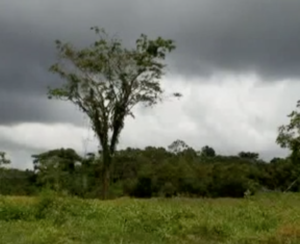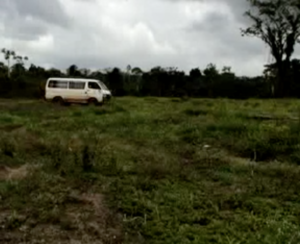(The short film Hyacinth is here.)
 I came to the idea of Paradise, the larger project of which Hyacinth is a part, through a course I took in graduate school on cultural geography. In that class, we talked about how landscapes where tragedies occur are treated after the event and how we can read cultural attitudes toward what or who was lost by the treatment of the land in the aftermath. When a site is rectified – that is, returned to a natural or undeveloped state – that speaks to the desire to forget. These are the sites I was interested in throughout the project, which took eight years to complete beginning in 2006. How and what we want to remember says a lot about what we value – not what we want to value, but what we actually value.
I came to the idea of Paradise, the larger project of which Hyacinth is a part, through a course I took in graduate school on cultural geography. In that class, we talked about how landscapes where tragedies occur are treated after the event and how we can read cultural attitudes toward what or who was lost by the treatment of the land in the aftermath. When a site is rectified – that is, returned to a natural or undeveloped state – that speaks to the desire to forget. These are the sites I was interested in throughout the project, which took eight years to complete beginning in 2006. How and what we want to remember says a lot about what we value – not what we want to value, but what we actually value.
To sensationalize a thing is to keep it Out There, to see nothing of oneself in it. I was passingly familiar with the story of Jonestown – that the term “drinking the kool aid” was a dismissive reference – when I watched Stanley Nelson’s excellent 2006 documentary Jonestown: The Life And Death of Peoples Temple. I was struck by the fact that a number of surviving former members still recall being a part of Peoples Temple as one of the most beautiful and important things they had ever done, despite its infamous and tragic end in which they lost both friends and family. There was nothing sensational about the loss they experienced. It was complicated and real, and I felt I understood it as grief. I wanted to explore the story of Jonestown as a story that was not Out There. For me, in this context, that meant visiting the geographic sight where it happened.
 The 2007 trip to shoot at the actual location of Jonestown, near the town of Port Kaituma in Guyana’s interior, was a trip into the unknown for me. I’m grateful to my friend Jake Galle for being willing to accompany me, particularly as I was advised by an anthropologist who’d worked in the region not to go by myself as a woman. Guyana has a negligible white population, and so Jake and I, who are both white, were rather conspicuous. Everyone assumed we were missionaries. At the time, Guyana basically had no tourist infrastructure – the Lonely Planet guide had literally yet to be published – so we traveled there on the hunch that the resources for the gold mining industries that drew on Port Kaituma would mean there would be somewhere to stay and somewhere to eat.
The 2007 trip to shoot at the actual location of Jonestown, near the town of Port Kaituma in Guyana’s interior, was a trip into the unknown for me. I’m grateful to my friend Jake Galle for being willing to accompany me, particularly as I was advised by an anthropologist who’d worked in the region not to go by myself as a woman. Guyana has a negligible white population, and so Jake and I, who are both white, were rather conspicuous. Everyone assumed we were missionaries. At the time, Guyana basically had no tourist infrastructure – the Lonely Planet guide had literally yet to be published – so we traveled there on the hunch that the resources for the gold mining industries that drew on Port Kaituma would mean there would be somewhere to stay and somewhere to eat.
The only place we could find to stay in Kaituma was a government-run guest house which was otherwise occupied by a utility company worker, and the woman who managed it cooked us dinners in her own kitchen. When the local government got word a couple of Americans were looking for someone to take them to Jonestown, we were summoned to the municipal office where we met with a not especially welcoming official in a military beret who wanted to know what exactly we were planning to do there. When we said we were artists, he immediately relaxed and, in my memory, waved his hand, saying, “Oh then do whatever you want.” We would learn that Jonestown is a painful national memory in Guyana, probably at least in part because it was the first and only time many Americans had heard of Guyana in 1978, a less than positive turn on the world stage.
Stanlry Nelson made the explicit decision to never use the word “cult” in his film, and that allows viewers to tune into the human community that was Jonestown. After doing some research, I found plenty of theories about brain washing at the settlement – as well as verified evidence of CIA presence – it seemed clear to me that community could be powerful enough without explicit manipulation to carry us along on a current that we would otherwise never allow to take us. That many people apparently did not go willingly on that day in November should not be ignored or forgotten, but that they were in Guyana in the first place speaks to the power of an idea, an ideal, a community, a desire to be part of something larger than oneself. It was not hard for me to imagine being enamored of such a group in its earlier and healthier days as many of those who died at Jonestown were.
I thought maybe I would feel something of a ghost or presence when we finally ended up in the jungle where our local guide assured us was the spot Jonestown stood. We weren’t GPS savvy so we will never know where our guide took us, really. I didn’t feel or sense anything. It could have been anywhere and really it was nowhere in particular. The rectification seemed to speak to the desire to forget the community and how it ended.
And yet there were still the people in Nelson’s movie saying it had been too beautiful once to ever forget.